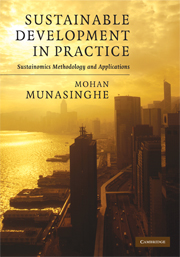Book contents
- Frontmatter
- Contents
- Foreword by James Gustave Speth
- Preface
- Part I Framework and fundamentals
- Part II Global and transnational applications
- Part III National and macroeconomic applications
- Part IV Sub-national sectoral and system applications
- Part V Project and local applications
- 15 Project applications
- 16 Local applications – hazards, disasters and urban growth
- References
- Index
16 - Local applications – hazards, disasters and urban growth
Published online by Cambridge University Press: 05 August 2012
- Frontmatter
- Contents
- Foreword by James Gustave Speth
- Preface
- Part I Framework and fundamentals
- Part II Global and transnational applications
- Part III National and macroeconomic applications
- Part IV Sub-national sectoral and system applications
- Part V Project and local applications
- 15 Project applications
- 16 Local applications – hazards, disasters and urban growth
- References
- Index
Summary
In this chapter, we use the sustainomics framework to analyse more localized events like hazards and disasters, as well as to assess the sustainability of growth in densely populated urban areas. Section 16.1 describes how the harmful impacts of hazards on both socioeconomic and ecological systems are often exacerbated by heightened vulnerability and prior damage inflicted by unsustainable human activities. A practical framework is presented for mainstreaming sustainable hazard reduction and management (SHARM) into national development – including the stages of relief, rehabilitation and reduction (planning, preparedness and prevention). Two-way linkages between hazards and sustainable development are analysed. In Section 16.2, the SHARM approach is used to assess the impacts of the biggest single disaster in modern history – the 2004 Asian Tsunami, which resulted in over 250 000 deaths in five countries (India, Indonesia, Maldives, Sri Lanka and Thailand). Effects on the macroeconomy, vulnerable sectors, employment and livelihoods, poverty, women and children and the environment are analysed, and appropriate policy responses are identified. A comparison of the impacts of the 2004 Asian Tsunami on Sri Lanka, and of Hurricane Katrina on New Orleans in 2005, raises important questions about the role of social capital in coping with disasters. Section 16.3 describes generic issues concerning the sustainability of long-term growth in Asian cities, arising mainly from growth and pollution affecting air, water and land. Policy options to address these problems are discussed – especially in the rapidly expanding mega-cities.
- Type
- Chapter
- Information
- Sustainable Development in PracticeSustainomics Methodology and Applications, pp. 544 - 587Publisher: Cambridge University PressPrint publication year: 2009



